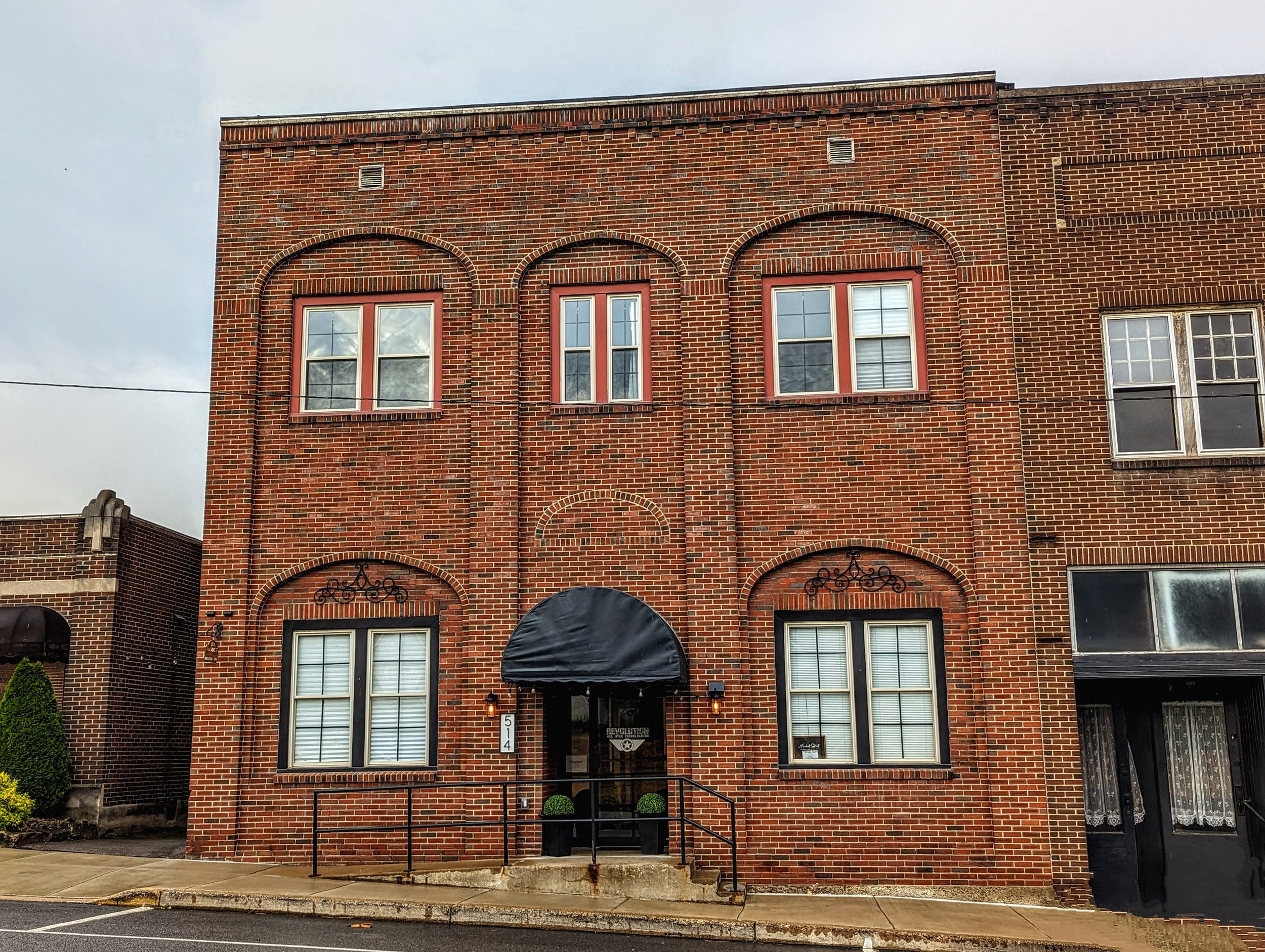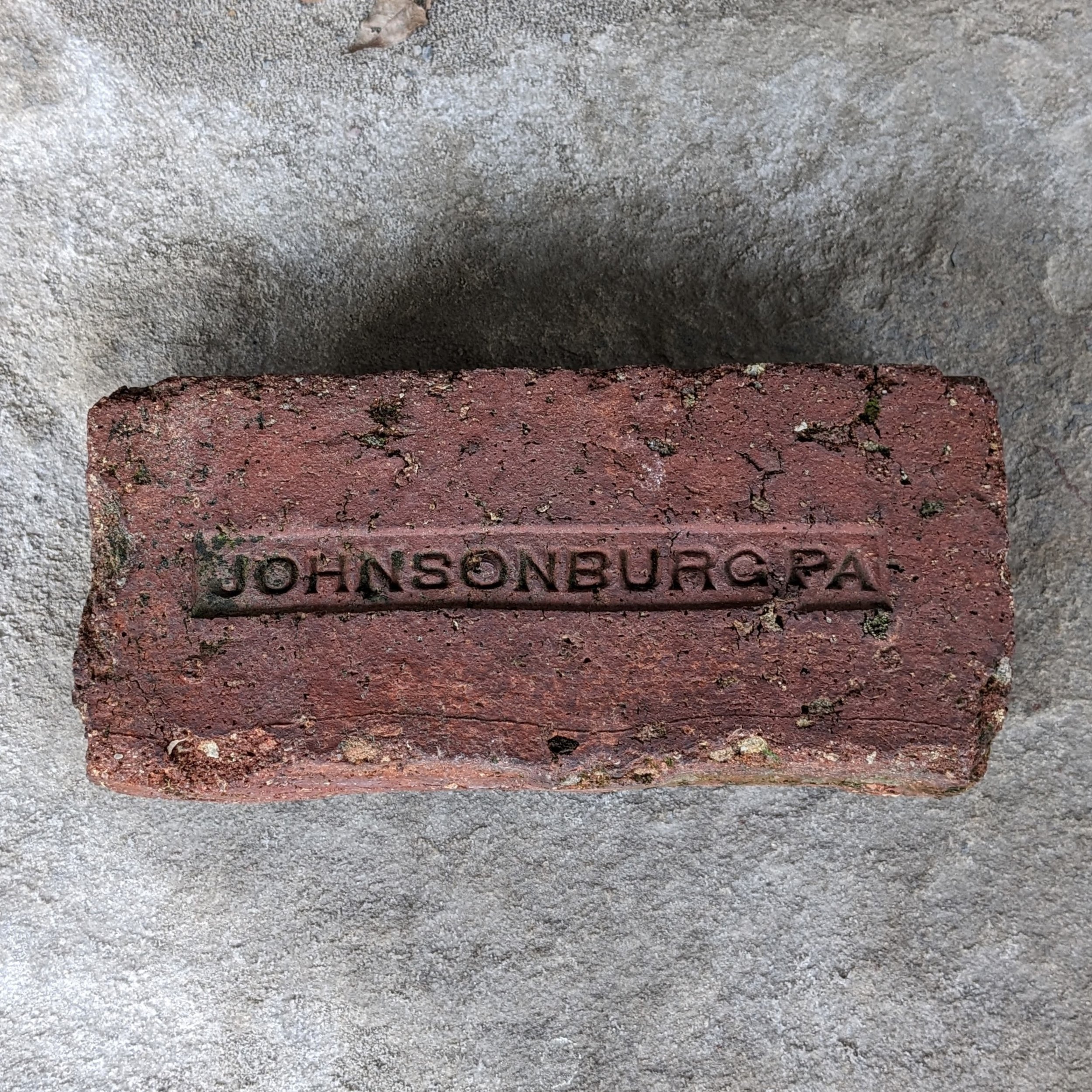The sole purpose of delivering Sunday newspapers in the East End of Johnsonburg in 1962 was to earn money to buy baseball cards and to play the pinball machines at Stelene’s Restaurant. I delivered about 70 papers and made two cents profit on the Pittsburgh papers and three cents on the Philadelphia editions, plus tips. The papers were a quarter and tips, generally a nickel, although not every household tipped. Baseball cards were five cents a pack and the pinball machine a nickel a play. What money I had left over at the end of the week went into my secret hiding place to accumulate with birthday gifts and odd jobs cash (no allowance, that was something that was only mentioned on TV shows). Eventually, my grandfather strongly suggested that I put those funds in the bank to earn interest and off to the Johnsonburg National Bank we went, laden down with a pile of bills and a bag full of various coins.
Image taken from a JCT past blog post, To a Kid this is a Castle .
Mrs. Sallack or maybe Ms. Florin helped me open up my savings account (no checking) and I received a little black bank book with the amount of my deposit written in and the date of deposit stamped next to it. I did not receive a monthly statement. With every deposit the teller would open up an accounting book, check my account, and add a little interest to my book. Very archaic compared to the slick bank books nowadays with their computerized printing.
The Johnsonburg National Bank was an imposing structure for an eleven year old; steep concrete steps going up to the doors between two massive pillars, it was a monumental stone edifice built grandly and solidly to give one the impression all monies were safe and secure in this rock solid garrison. Even the windows had bars and etched in stone above the entrance was the profound identification, B A N K.
Inside I recall the teller’s windows to the left and a large writing table along the wall to the right, at the time I was so short I could barely see into the teller’s opening or rest my elbows on the table. Straight to the back I remember a caged area that I understood contained the bank vault. Inside the front door an elderly gray-haired lady stood in uniform with a tambourine collecting donations for the Salvation Army. Whether or not she was there everyday I do not know but she always seemed to be there whenever I arrived.
The Johnsonburg National Bank charter was filed on October 30, 1890 and the building of the castle-like structure was begun around that time. Like the “Brick Block” the bank was designed by architect P. A. Welsh of Philadelphia. It was built under the direction of stonemason Gustav Florin and possibly stonemason Lars Johnson for $20,000.
Gustav Larsson Florin immigrated to the United States from Sweden in 1889 with his wife Ingrid and two children and settled in Johnsonburg, and his erstwhile friend and future partner in business, Lars Mangus Johnson, came from Sweden in 1879, married his wife Ida in Daguscahonda, Pennsylvania in 1882 and came to Johnsonburg around 1889. Both Gust and Lars were journeymen masons and particularly adept at stone cutting. They came to Johnsonburg at the bequest of the Armstrong brothers, helped build the brick paper mill and also the Brick Block. Gus and Lars built the Florin-Johnson structure which for many years housed Bosler’s Drug Store, the Corner Restaurant, John Mann’s Cigar Store, Jenks lady clothing and accessories store, and many other shops along Cobb Street until it was torn down in 1970 to make room for the improving(?) of Route 219. In 1903 they both partnered to open a plumbing store in the Brick Block and they both are responsible for erecting the many brick and stone chemical plants in the area. In April 1909 Gust and L.M. build a brick storage building in Spring Creek, Warren County for $25,000. The building stored eggs, butter, and poultry from the area and was cooled by machinery; a very modern enterprise in the days of ice box deliveries. Gust Florin also built the Elk County Home in St, Marys, Pennsylvania.
The Johnsonburg National Bank opened on April 6, 1891 with $50,000 working capital and a surplus fund of the same amount. E.O. Aldrich is the cashier and paper mill owner Meylert M. Armstrong is President. With a National Bank designation the bank was permitted to print its own United States currency. You can find examples of these interesting bank notes online by googling “Johnsonburg Bank Notes.”
On July 8, 1893 E.O. Aldrich, well-respected cashier of the Johnsonburg National Bank, is asked to help adjust matters at the defunct Ridgway Bank. J. H. Peoples will act in the capacity of cashier in his place and Peoples’ place as teller will be filled by Frank O’Connell, both men of sterling integrity. On October 18, 1894 the receivers of the defunct Ridgway National Bank which closed its doors on June 23, 1893 announced that they will pay a 20% dividend through the Johnsonburg National Bank.
A little over a month later on November 23, 1894 Harry Peoples, 24, bank clerk, was found dead in his room over the Johnsonburg National Bank. Two bullet holes in his head and a .32 caliber revolver is by his side. Harry had no bad habits and his death is a large mystery. A coroner’ inquest failed to shed any light on the tragedy. He left no note or other evidence of premeditated suicide. He was engaged to be married to popular young Miss Inez Hyatt, a Johnsonburg school teacher, who is nearly distracted over the shocking death of her betrothed. Peoples was in good spirits when last seen alive. (You can read the whole story in the book “The Paperboy from the Paper City'').
In the early days the Commonwealth of Pennsylvania often invested its treasury’s money in Pennsylvania banks. For example, on May 31, 1911 the State reported that $20,000 in taxpayer dollars was on deposit at the Johnsonburg National Bank.
In July, 1913 a new safe was installed at the Johnsonburg National Bank. The new vault is constructed of reinforced concrete lined with steel. The door weighs five tons and opens on a timer and combination lock. The manganese safe inside the vault is only opened by a combination lock. Safety deposit boxes inside the vault are now available. The old 3,600 pound safe from the bank is moved to the New Clarion Hotel on Centre Street. While transferring the safe the workers dropped it, making a great impression on the sidewalk!
On November 3, 1920 around 8:00 a.m. Dr. William Palmer and Gust Florin, the Johnsonburg National Bank’s builder and now wealthy contractor, are traveling to Ridgway where Dr. Palmer of Johnsonburg is chief surgeon. The new road to Ridgway had just been completed and Dr. Palmer and Mr. Florin were the first to motor the freshly concreted highway. Two miles from the center of town with Dr. Palmer driving, the car skidded into a ditch and turned over. Both men were seriously injured with Dr. Palmer expiring upon arrival at the Ridgway Hospital. Gust Florin was not expected to live but miraculously survived.
Frank O’Donnell, longtime bank employee, is the head cashier and a bank director in the 1920’s. His untimely death of a heart attack at age 58 results in Alvin A. Johnson of Rolfe, Pennsylvania taking over as head cashier.
April 28, 1929- The Johnsonburg National Bank is closed for remodeling. A new vault and an updated lobby is being constructed. All banking transactions and other business is to be done at the Johnsonburg Community Building until further notice.
January 1937-V. M. Slouck, an upper management employee of the New York and Pennsylvania Company, is named President of the Johnsonburg National Bank. Mr. Slouck resides in Lock Haven. Bank employees of the time are; cashier A. A. Johnson, assistant cashiers, N.R. Gardner and J.J. Bliskey. A year later Alvin A. Johnson succumbs to pneumonia at age 50 and Norman Randall Gardner is promoted to head cashier.
In November 1951 the Johnsonburg National Bank announced it would pay out in a few weeks over $75,000 in Christmas savings. It is the largest Christmas fund in Elk County.
On February 15, 1952 two masked gunmen held up the Johnsonburg National Bank of over $7,000. They will eventually be caught and a bank robbery conspiracy involving local residents will unravel. (You can read the whole story in the book “The Paperboy From the Paper City”).
November 25, 1957-Over $96,000 paid out in Christmas savings from Johnsonburg National Bank, largest in Elk County.
The Warren National Bank, capitalized at $53.2 million, merged with the Johnsonburg National Bank, capitalized at $5.1 million, on November 22, 1963. This will supposedly for all intent and purposes end the control of the Johnsonburg National Bank by the New York and Pennsylvania Company. The Company had always been placed on the bank’s Board of Directors management from the New York and Pennsylvania Company. The Johnsonburg National Bank and the Johnsonburg community had grown substantially together from their mutual inception.
In the mid-1960’s N.R. Gardner retires and Norman Jerry Nelson takes over as bank manager. The bank undergoes some major changes. An outside, walkup bank window is installed on the Bridge Street side of the edifice, the front entrance is remodeled with a two-stair approach, and a snow-melting system is placed under the front concrete sidewalk.
1-17-1968- N.R. Gardner is placed on the board of directors. Local advisory board is N.R. Gardner, George Mosebarger, H. H. Bell, V. M. Stouck, H. L. Wallis, R. K. Guinard, F. W. Crowe, N. J. Nelson, bank manager. Although the merger of 1963 was to remove New York and Pennsylvania Company control of the bank you can read by the board of directors that many upper management of the Company remain on the board. Stouck, Wallis, Guinard, and Crowe all work for the paper mill.
On June 30, 1982 the Warren National Bank was taken over by Marine Bank of Erie, Pennsylvania making the Johnsonburg bank part of the Marine Bank system.
In September 1996 Marine Bank was merged with PNC Bank. Three years later the Johnsonburg PNC Bank was taken over by County National Bank of Clearfield, Pennsylvania.
Norman Jerry Nelson retired as bank manager in 1999.
On February 2, 2008, for the second time in its 118 year history the Johnsonburg bank was robbed. A Wilcox, Pennsylvania resident robs the Johnsonburg County Bank of $21,000 with a toy gun. He came into the bank by the side door, ordered two tellers to get on the floor, and escaped in a car parked in the alley between Market and Penn Street. The car was described as a Suzuki Vitara. The perpetrator was apprehended by the St. Marys Borough Police at the Straub Brewery in St. Marys.
On January 8, 2013 the Johnsonburg CNB bank was robbed again, this time by a Ridgway resident.
In 2015 CNB closed the Johnsonburg branch and in 2016 the Johnsonburg Water Authority took over the old bank building for their offices.
For many years the castle-like structure provided a safe haven for deposits and valuables and granted loans and mortgages that enabled Johnsonburg to grow and prosper through its “heyday” years. Northwest Bank has taken over that service for current Johnsonburg citizens but the ancient stone fortress on the corner of Market and Bridge Streets still stands today as a solid symbol of Johnsonburg strength and fortitude.
Kevin “Reg” Barwin
2023
Kevin Barwin, a Johnsonburg native, who spent his youth peddling newspapers in Johnsonburg and reading the newsprint, while walking his routes, acquired a taste for the past.
THE PAPER BOY FROM THE PAPER CITY, More on his book: here























